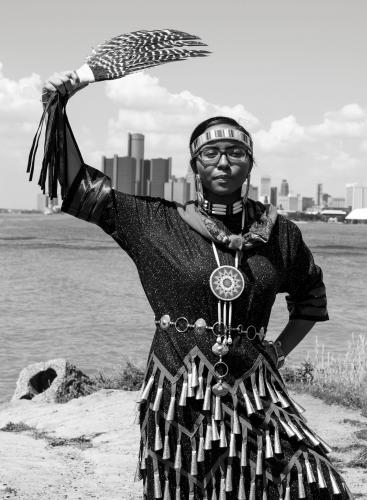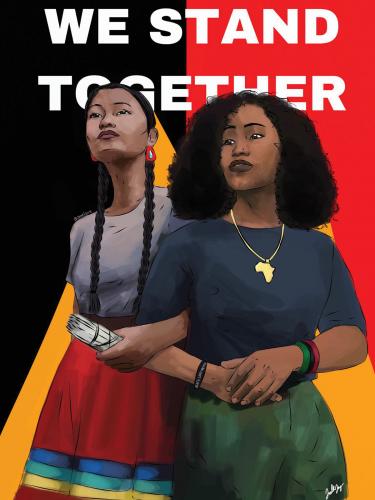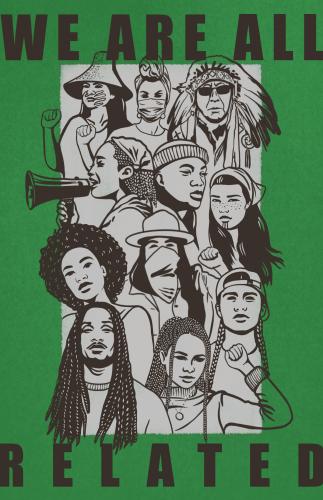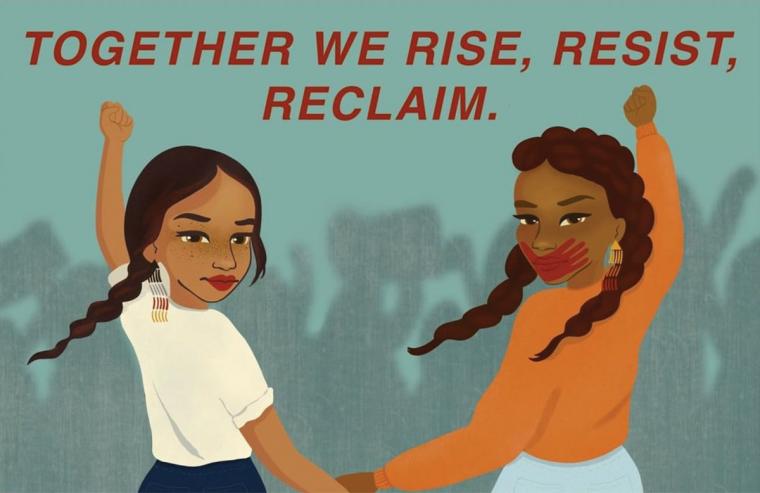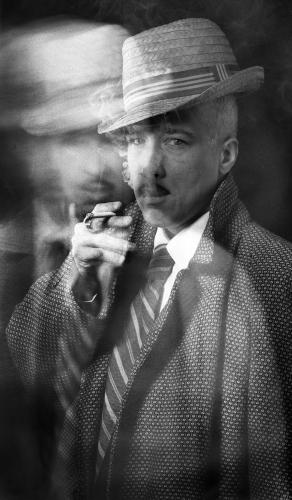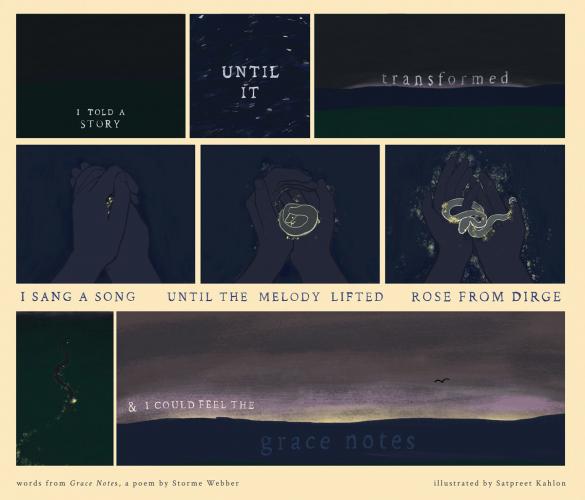“Solidarity between Indigenous and Black people is a must,” says artist Storme Webber. “Our histories are complex, and we need to learn about one another.”
Webber is one of several Black-Indigenous artists whose works move beyond the idea of the singular “Native experience” or the “Black experience.” Their distinct approach to creating art draws from the shared histories of Indigenous and Black communities and intertwined struggles in the Americas.
In June 2020, three artists—Joelle Joyner (Black and Kauwets’a:ka descent), Paige Pettibon (Black and Salish descent) and Webber (Black, Sugpiaq and Choctaw descent)—created free, online posters through the yəhaw̓ Indigenous artist collective. They offered their work for anyone to post, print and share at local and global protests and demonstrations. These artists and the yəhaw̓ collective have been raising awareness about social issues to affect positive change in their communities and beyond.
yəhaw̓ is a group of Indigenous creatives based in Coast Salish territories of Washington state committed to developing community leaders and making space for Indigenous art through cultural, art and design services. The word “yəhaw̓ ” means “to proceed, go forward, do the work” in the Lushootseed language. yəhaw̓ is inclusive, welcoming global Indigenous people and centering Indigenous voices, especially those of womxn (a term inclusive of trans and nonbinary women), Two Spirit (a term used by some Native people to describe third and fourth genders and/or people possessing both male and female spirits) and youth.
The collective is led by a curatorial team consisting of Asia Tail (Cherokee Nation), Satpreet Kahlon, Kimberly Deriana (Mandan/Hidatsa) and Tracy Rector (Black and Choctaw/Seminole descent). Team members share responsibilities, each drawing upon separate strengths in writing, curation, programming, fundraising and grant writing. A number of community curators help develop exhibitions and projects at various locations.
yəhaw̓ began as a yearlong project culminating in the exhibition “yəhaw̓: Together We Lift the Sky,” which opened in March 2019 at the ARTS at King Street Station, a cultural hub in Seattle, Washington. The exhibition’s subtitle derived from the “Lifting the Sky” story told by Tulalip Chief William Shelton in 1923, narrating how, a long time ago, the sky was so low that people could not stand upright. The people came together and realized that they needed a community effort pushing upward at the same time. When all the people and animals used their strength together, the sky lifted high above. The values of the “Lifting the Sky” story guide the principles and programming at yəhaw̓.
The yəhaw̓ show featured more than 200 artists from more than 100 Indigenous nations. The curatorial team accepted works from all Indigenous artists who answered an open call. The curators included creatives who would be considered masters at their arts alongside emerging artists who were exhibiting for the first time. More than 2,700 people attended the opening celebration, which featured a community breakfast by chef Hillel Echo-Hawk (Pawnee/Athabaskan), a performance by Lummi Nation Blackhawk Singers and other performances and art activities.
yəhaw̓ has continued to expand its projects, offering more exhibitions, workshops, trainings, artists-in-residence programs, literary and art zine publications, and COVID-19 relief minigrants to other artists. As explained on the website, “yəhaw̓ unsettles assumptions and centers Indigenous action, Indigenous innovation, and Indigenous agency to author our own stories.”
After the May 25, 2020, death of George Floyd during his arrest by a Minneapolis police officer and the killings of other unarmed Black people by police, yəhaw̓ wanted to show support without taking space from Black voices. The collective released a statement on its website addressing “Black relatives” and offering a “thank you to the protectors marching in the streets, thank you to those posting messages of solidarity at home, to those donating, to others having hard conversations with friends or family, and to the artists finding ways to express our grief.” The collective considered how it could be responsive to the needs in the Black community while highlighting people’s voices through art. The result was a series of protest posters featuring art by Black-Indigenous artists. Community curator Britt Reed (Black and Choctaw descent) led the project and worked with the three artists. She says the posters "reflect on the impact of violence and cooperation within Native and Black communities, particularly for those of us who are Black Natives."
Originally from Detroit, Michigan, Joyner is an undergraduate public health student at Wayne State University. She uses her art to connect people to cultural movements and her Black-Indigeneity. Recently her artwork was featured in the children’s book “Our Smallest Warriors, Our Strongest Medicine: Overcoming COVID-19,” published by the Johns Hopkins Center for American Indian Health.
She says her poster, “We Stand Together,” shows how Black and Indigenous peoples have different yet overlapping struggles against oppression. The two women are linking arms in solidarity. The Indigenous woman is wearing a ribbon skirt, and the red symbolizes MMIW [Murdered and Missing Indigenous Women] awareness. The Black woman wears the colors of the pan-African flag and a #BlackLivesMatter bracelet.”
Joyner’s poster was her first project with yəhaw̓ and her first creation of “action art.” She says, “I was very honored to express solidarity and allyship. As someone who is of Black and Kauwets’a:ka descent, I wanted to show my support for the healing of both Black and Indigenous communities.”
The other two artists who created protest posters through yəhaw̓, Pettibon and Webber, had participated in previous yəhaw̓ projects, including the King Street Station exhibition.
Born and raised in Tacoma, Washington, Pettibon is Black and Salish descent from the Confederated Salish and Kootenai Tribes of the Flathead Reservation in Montana. Now a language instructor for the Lushootseed Language Institute, she was an educator for Puyallup tribal schools. A multidisciplinary artist who works in mixed media, graphic arts, fiber and beadwork, Pettibon illustrated two posters with six different messages. She explained that the first, her green Black Lives Matter [BLM] poster, “illustrates a diverse crowd fighting for the cause. I chose to omit skin tone because some issues center around colorism, and I wanted the poster to focus on the people fighting for equity. There is no hierarchy, no competition, just people supporting each other.”
Pettibon says that her second poster, “Together We Lift the Sky,” shows the “Indigenous and Black community’s support for each other. I hope this illustration appeals to young folks as they are the future, and we know the work we do today is not just for us but for them as well.”
Reflecting on the poster project, Pettibon remarked, “I felt we had the perfect group of Afro-Indigenous artists to create the BLM posters,” she says. “My work is in-line with activism. Through art I reflect and express my perspective as a Black Indigenous woman, making my way in an urban setting, away from my tribal lands. I wanted these posters to focus on Black and Indigenous people coming together in solidarity.”
Like Pettibon, Webber is also from Washington state. She was born and raised in Seattle and is descended from Sugpiaq (Alutiiq) women with origins in Seldovia, Alaska, and from Black and Choctaw women from the Deep South. Webber is a Two Spirit poet and performance artist whose work incorporates text, audio, photography and archival documents. Her recent solo exhibition, “Casino: A Palimpsest,” at the Frye Art Museum used photographs, archival documents and poetry to explore one of the West Coast’s oldest gay bars.
Webber’s poster was a collaborative work featuring lines from her poem, “Grace Notes,” with an illustration by yəhaw̓ co-founder Satpreet Kahlon. The poem’s words, taken from the “Casino: A Palimpsest” exhibition, “are meant to share the transformation possible as we reflect on our lives and ancestral journeys,” she says. “I think it was a clarity around my years of unintended and natural inquiry into my family, especially my mother’s side. Like so many people, I’ve been searching through absences and silences and shame, and it became necessary to witness the light, the lift, the ease and the beauty even through sorrow and oppression. ‘Grace Notes’ represents those moments. If there was no grace, we would not be here to tell the tale.”
Webber was delighted that the new yəhaw̓ project carried forward the theme of solidarity between Indigenous and Black people. “White supremacy and capitalism have often set us against each other. We have so much to do in rebuilding this world in the right way.”
Visit yehawshow.com for more information about the collective and its upcoming artist calls.

